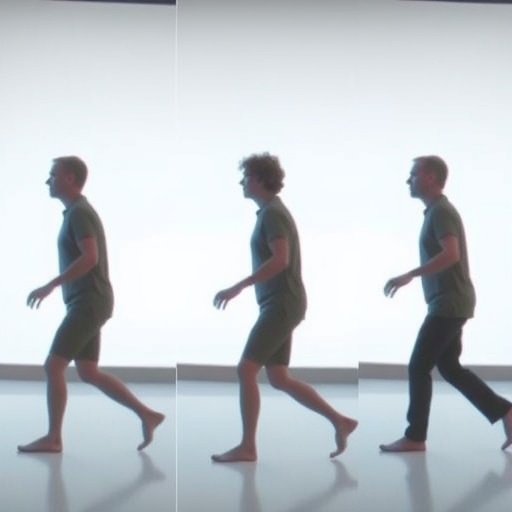
In a groundbreaking advancement for neurodegenerative disease research, a recent study has leveraged sophisticated video analysis techniques to unveil early motor abnormalities characteristic of bradykinesia in individuals with REM sleep behavior disorder (RBD) and Parkinson’s disease (PD). This seminal work, conducted by Guarín and colleagues, underscores the potential of non-invasive, remote diagnostic tools to detect subtle motor impairments well before the onset of overt clinical symptoms, offering a transformative approach to early diagnosis and intervention in Parkinson’s and related synucleinopathies.
Bradykinesia, defined as the slowness of voluntary movement, is a cardinal feature of Parkinson’s disease, often manifesting in the earliest stages of motor dysfunction. Traditionally, bradykinesia detection relies heavily on clinical observation and subjective rating scales such as the Unified Parkinson’s Disease Rating Scale (UPDRS). However, these methods are limited by inter-rater variability and the necessity for in-person clinical assessment. The utilization of video analysis, as presented in this study, circumvents these barriers by offering objective, quantifiable metrics that can be evaluated repeatedly and remotely.
The researchers meticulously analyzed video recordings of patients diagnosed with REM sleep behavior disorder—a prodromal condition strongly associated with eventual development of Parkinson’s disease—and those with established PD. By employing advanced computational algorithms, they extracted precise kinematic parameters from simple hand movement tasks, such as finger tapping and hand opening–closing cycles, previously known to be sensitive indicators of bradykinesia. These parameters included movement amplitude, velocity, and rhythm regularity, revealing subtle but statistically significant motor slows that escaped conventional clinical notice.
.adsslot_30BJWnQmI2{width:728px !important;height:90px !important;}
@media(max-width:1199px){ .adsslot_30BJWnQmI2{width:468px !important;height:60px !important;}
}
@media(max-width:767px){ .adsslot_30BJWnQmI2{width:320px !important;height:50px !important;}
}
ADVERTISEMENT
One of the most striking revelations of this study lies in the detection of early bradykinetic signs within the RBD cohort, who are conventionally considered asymptomatic from a motor standpoint. The findings suggest that the neurodegenerative process underlying Parkinsonism begins to alter motor circuits far earlier than previously appreciated, challenging the traditional clinical diagnostic timelines. Such early detection could dramatically shift therapeutic strategies toward neuroprotective interventions in the prodromal phase, potentially delaying or attenuating disease progression.
The methodology developed by Guarín et al. integrates state-of-the-art machine learning and computer vision techniques to parse and interpret complex motor patterns. Their analytical pipeline not only enhances the sensitivity for detecting bradykinesia but also reduces noise inherent in video data, such as variable lighting and recording angles. This robustness makes the approach highly adaptable for real-world clinical and home-based monitoring scenarios, democratizing access to early Parkinson’s diagnostics and extending its reach beyond specialized movement disorder clinics.
Moreover, the study highlights the importance of RBD as a critical window for understanding the pathophysiology of synucleinopathies. RBD, characterized by dream enactment behaviors due to loss of normal muscle atonia during REM sleep, has been established as a strong predictor of Parkinson’s and related disorders. By identifying motor abnormalities in this population, the research provides compelling evidence for a continuum of neurodegeneration measurable through non-invasive means, reinforcing the notion that motor features evolve progressively rather than appearing abruptly at disease onset.
In addition to its clinical implications, the integration of video-based motor assessment could revolutionize patient monitoring in clinical trials. Objective, reproducible, and scalable motor biomarkers are the cornerstone of evaluating therapeutic efficacy. Utilizing digital phenotyping platforms incorporating video analysis may allow for longitudinal tracking of disease progression and subtle treatment effects that remain elusive through traditional clinical rating scales.
The study also contributes to the growing corpus of digital health interventions that harness ubiquitous technologies such as smartphones and webcams for disease detection and management. The potential to implement video analysis remotely offers a paradigm shift particularly relevant in the context of global health challenges, where access to neurological care might be limited. Early identification and intervention become more feasible, fostering personalized medicine approaches and improving patient outcomes.
Nevertheless, the application of video analysis as a diagnostic adjunct is not without challenges. Variations in recording environments, patient compliance, and the need for standardized protocols persist as hurdles to widespread adoption. The authors acknowledge the necessity for multicenter validation studies encompassing diverse populations to ensure generalizability and robustness of their findings before clinical implementation.
Future directions illuminated by this work include the potential integration of multimodal data streams, combining video-derived kinematics with wearable sensor data, genetic profiles, and neuroimaging biomarkers. Such a holistic approach could unravel the complex phenotypic heterogeneity observed in Parkinson’s disease, tailoring diagnostic and therapeutic strategies to individual patient profiles.
This research marks a pivotal point in neurodegenerative disease diagnostics, illuminating the capacity of computational video analysis to detect the faint tremors of disease long before they crescendo into clinical parkinsonism. Its implications extend beyond Parkinson’s, suggesting applications in other movement disorders where subtle motor manifestations precede diagnosis.
As Parkinson’s disease continues to impose a growing global burden, innovations in early detection promise to redefine clinical practice and therapeutic development. Guarín and colleagues’ pioneering video analytic approach exemplifies how the convergence of digital technologies and neuroscience can yield transformative insights, potentially ushering in a new era of precision neurology.
The evocative images and data representations accompanying the study add a compelling visual dimension to these findings, depicting the measurable differences in motor activity with clarity and precision. Such visual tools serve not only scientific communication but may also empower clinicians and patients alike, facilitating understanding and engagement with disease monitoring.
In conclusion, this landmark study expands the frontier of Parkinson’s disease research, demonstrating that bradykinesia—long thought to debut in clinically overt stages—may be detectable in prodromal cohorts through advanced video analysis. This insight heralds a future where early diagnosis is feasible, interventions can be timely, and patient trajectories significantly improved through technology-enabled precision medicine.
Subject of Research: Detection of early bradykinesia signs in REM sleep behavior disorder and Parkinson’s disease utilizing advanced video analysis techniques.
Article Title: Video analysis reveals early signs of Bradykinesia in REM sleep behavior disorder and Parkinson’s disease.
Article References:
Guarín, D.L., Acevedo, G., Calonge, C. et al. Video analysis reveals early signs of Bradykinesia in REM sleep behavior disorder and Parkinson’s disease. npj Parkinsons Dis. 11, 222 (2025). https://doi.org/10.1038/s41531-025-01082-0
Image Credits: AI Generated
Tags: clinical observations vs. video analysis in PDcomputational algorithms in movement analysisearly diagnosis techniques for Parkinson’simplications of earlymotor abnormalities in REM sleep behavior disorderneurodegenerative disease research advancementsnon-invasive methods for assessing Parkinson’s symptomsobjective metrics in bradykinesia evaluationParkinson’s disease and synucleinopathiesremote diagnostic tools for Parkinson’s diseaseslowness of voluntary movement in neurodegenerationvideo analysis for early detection of bradykinesia




